Is mold on a mattress dangerous?
Most of the time, mattress mold does not cause any problems. However, excessive mold growth can still affect the integrity of your mattress and start to break down the materials. In addition, if you or your family struggle with seasonal or environmental allergies, mold may trigger your allergy symptoms. This, in turn, can cause issues like congestion, headaches, disturbed sleep, or even acid reflux due to increased sinus drainage.

There's also the fact that mold spreads very easily. Once you have mold on one surface, it can quickly spread all over your home, increasing your risk of developing allergic rhinitis or more extensive damage to your belongings. Because of this, even though mold isn't usually dangerous (except for certain specific varieties), it's a good idea to keep mold out of your home and off of your furniture—for the good of your overall health and well-being.
How do I know if my mattress has mold?
Aside from wondering how to clean mold off a mattress, many people wonder how they would even know if mold was present. Thankfully, there are several clear signs that something is amiss—and that mold might be the culprit.
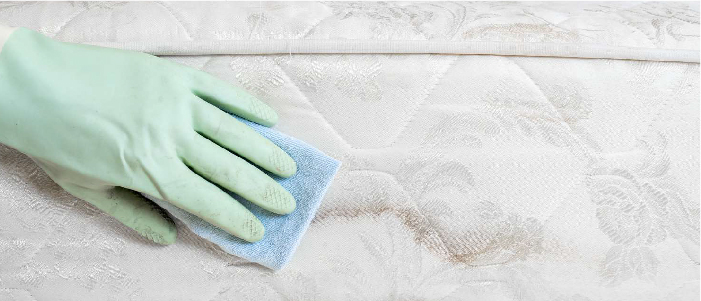
Foul odor
Unpleasant smells without a clear source can often be a sign of mold growth. In general, mold tends to smell sour, musty, or rotten—kind of like a very dirty fish tank.
Stains
Blotches of green, brown, or purple are common signs that mold is present. At this point, it's likely that the mold is more widespread than it appears, since smaller infestations are not usually visible.
Physical symptoms
If you start having allergy symptoms like itching, sneezing, wheezing, coughing, headaches, and congestion—especially if they're more noticeable when you're in bed or shortly after you wake up—mold on your mattress may be the culprit. Mold growth may also aggravate sleep problems like insomnia, snoring, and even sleep apnea.
Pest infestations
Unfortunately, mold growth can also attract household pests such as gnats, mites, and more. The pungent smell of mold can even attract termites!
Mold elsewhere
Because mattresses are soft and porous, they make an ideal breeding ground for mold spores. However, since spores are spread through the air, they can easily reach other areas of your home. If you find mold on your walls or floors, especially in your bedroom, it's likely that the same mold is inside your mattress too. Since mold isn't always visible, it's also a good idea to look for signs of warping on hard surfaces like wood or drywall, since this can be a sign of mold growth.
What causes mold on a mattress?
Mattress mold is caused by fungal spores that float through the air all around us. When they come to rest on a damp surface or in a humid environment (such as furniture, walls, and carpets), they can multiply rapidly—especially if they have access to a plentiful food source, such as the dead skin cells commonly found on mattresses.
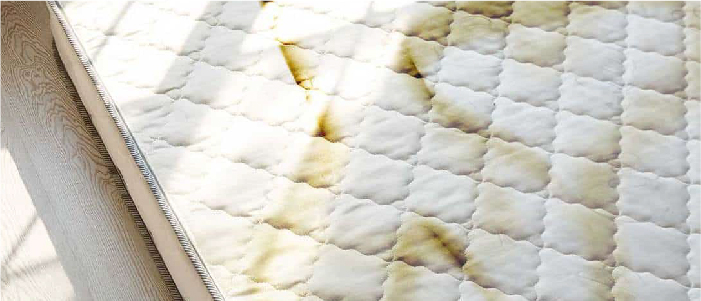
What does mold on a mattress look like?
Mold is typically white, brown, orange, yellow, green, or purple in color. It can be fuzzy-looking or slimy—as opposed to mildew (a relative of mold), which is often more fluffy or powdery. Most of the time, the mold that is found on mattresses is brown, green, or purple. However, it's important to note that mold is often not visible to the naked eye until it accumulates pretty heavily. That is why it is so important to clean your mattress on a regular basis, even if it doesn't look dirty.

How to Prevent Mold on a Mattress
If you're wondering how to prevent mold on a memory foam or latex mattress—or even a traditional box spring—we've got you covered with all the tips you'll ever need.
Clean regularly
One of the best ways to prevent the growth of mold on any surface is to keep it clean. Clean up any spills quickly and thoroughly—and keep up with a regular cleaning schedule. This will not only help you remove mold from a mattress, it will also remove the food sources for mold, bacteria, and pests—things like dead skin cells, sweat enzymes, actual food particles, and more. It's also a good idea to change your bed sheets every other week. This will help prevent these particles from accumulating on your mattress—and encourage you to inspect it regularly for mold.
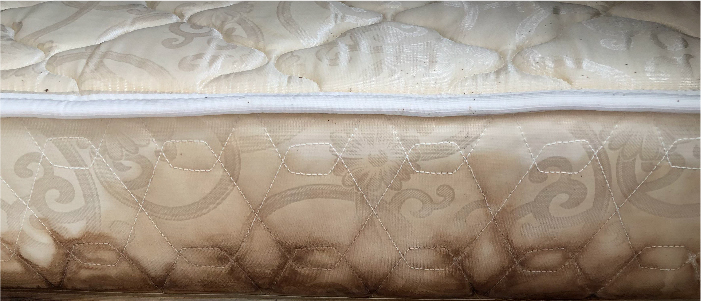
Control humidity
Mold and bacteria thrive in warm, damp environments. That's why it's crucial to control the humidity levels in your home. If your thermostat does not have a hygrometer (the tool that measures humidity) built in, you can easily get one from any hardware store or home improvement store for just a few dollars. Ideally, it's best to keep humidity below 50% in order to prevent mold growth. If the humidity level gets too high, you can use a dehumidifier to get it back on track.

Clear the air
Air purifiers and air sanitizers can significantly improve the air quality inside of the home. Not only do they promote healthy air circulation, they also filter out dander, dirt, mold spores, and other materials that can be irritating (or even harmful) to our respiratory tracts. The most effective filters and sanitizers against mold are ones with a HEPA filter or an active carbon filter—or those that use UV-C light. These can help eliminate mold spores and stop reproduction.
If you can't get an air purifier right away, you can still help reduce mold growth by running your furnace fan, turning on the A/C, or opening your windows on a nice day. These methods are not as effective at fighting mold, but they can still lower the amount of spores that are floating around your home—and potentially lower humidity.

Let in light
Did you know that sunlight can kill mold spores naturally? As part of your normal cleaning routine, try opening the shades and removing your bedsheets on sunny days. This can help keep mold spores and other pathogens down to a manageable level.

Try antimicrobials
Antimicrobial treatments designed for mattresses and furniture can be very helpful for keeping your mattress clean, especially if you already have existing mold stains you are trying to clean up. These compounds inhibit mold growth while simultaneously killing other fungi, bacteria, and viruses that can make you sick and cause unpleasant odor.

Use barriers
It's a very good idea to use fabric covers on all of your mattresses—and never sleep directly on the surface. This will help prevent the accumulation of sweat and dead skin cells that mold spores feed off of, and make it easier for you to keep the mattress clean.
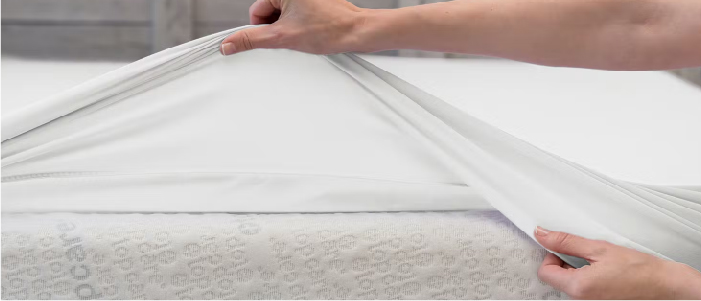
Change your base
Using a slatted base, rather than a traditional box spring on a flat platform, structure for your mattress. This helps to encourage air circulation on both sides of the mattress, keeping it clean and dry. Never keep your mattress on the floor; the poor ventilation and heat accumulation can make mold grow even faster!

How to Remove Mold from a Mattress
With all those pesky mold spores floating around in the air 24/7, you might be wondering: can you get mold out of a mattress? The answer is yes, you absolutely can—and we're about to tell you how.
Step 1: Assess the situation
Many DIY cleaning techniques will only work if the mold hasn't already penetrated deeply into the mattress. This is why it is so important to take care of mold as soon as you notice it—before it has a chance to establish itself in the core of the item. If the mold you clean off quickly grows back, it's likely that the mold has penetrated deeper into the core of the mattress, and you'll need to take more drastic measures. At this point, we would recommend replacing your mattress and disposing of it at an approved recycling or waste removal facility.

Step 2: Check best practices
Before you use any of our recommended methods, it's a good idea to check with the manufacturer of your mattress for cleaning instructions. If you don't have a user manual or guidebook handy, you should still be able to find information on the manufacturer's website. If not, you can call the company to learn more.

Step 3: Vacuum the surface
You can use a standard household vacuum to clean out dust, dirt, and even some mold around the surface of your mattress. It is even more effective if you can use a vacuum equipped with a HEPA filter. When you're finished, be sure to wipe down the inside and outside of your vacuum cleaner with a recommended mold-killing product to prevent any spores from spreading throughout your home—otherwise you'll be right back where you started.
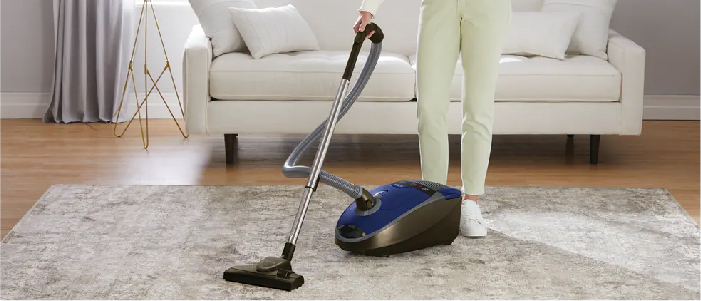
Step 4: Apply the cleaning mixture
For cleaning most mattresses, we recommend a 50/50 mixture of warm water and rubbing alcohol. This helps disinfect the area by killing the mold spores and any other harmful pathogens. Use an absorbent cleaning cloth to fully soak up the liquid, then ring out the cloth until damp. This will help prevent too much water from getting into the mattress and exacerbating your problem. Just rub the cloth in a circular motion, using moderate pressure.

Step 5: 'Rinse' the area
Using another cleaning cloth dampened with plain, warm water, thoroughly blot the treated area. This will remove any remaining traces of mold and prevent buildup of the cleaner you used.

Step 6: Disinfect as desired
You can further clean your mattress using a disinfectant. This can help remove bacteria, mold spores, and other pathogens that may be harming your mattress—and your health. Just be sure to check your manufacturer guidelines for product recommendations or restrictions. You should also make sure that the active ingredients in your cleaning product can safely be mixed with rubbing alcohol, since mixing certain components can cause production of harmful gasses that can make you and your family sick. When in doubt, check with your doctor and/or your local poison control center.

Step 7: Dry the mattress
Once you have cleaned the mattress as thoroughly as possible, it's important that you dry out the mattress to prevent growth of additional molds and bacterias. Place the mattress in a highly ventilated area, preferably with sun exposure, as sunlight can also help inhibit the growth of mold.

Frequently Asked Questions
Does bleach kill mold on a mattress?
Technically, yes; bleach can kill mold on a mattress. However, bleach is also a highly corrosive cleaning agent, which can damage the delicate fibers of your bed in addition to staining the surface. Because of this, we typically recommend rubbing alcohol or hydrogen peroxide instead.
Can foam mattresses get mold?
Yes. Foam mattresses can get mold. In fact, pretty much any surface (both porous and nonporous) can get infected with mold spores. This is especially true if the surface itself is damp or if it resides in a damp environment.
Can latex mattresses get mold?
Yes. Latex mattresses can absolutely get mold. Any surface, whether porous or nonporous, has the capability of being infected with mold spores, especially if the surface is damp or is in a damp environment.
Can urine on the mattress cause mold?
Yes. Urine on a mattress can cause mold growth. This is because any source of dampness or humidity can create an environment where mold spores thrive.
Summary
No matter what kind of mattress you use, mold can happen. Thankfully, there are some simple, affordable ways to prevent it—things like cleaning regularly, improving ventilation, and controlling the humidity levels in your home. Plus, thanks to our comprehensive guide, you know how to get mold out of a mattress if it does move in—and take back your bedroom, for good.
Please Let Us Know What You Think
Have you struggled with mold in your home? Have you recently bought a new mattress due to mold problems? Please leave a comment below and tell us about it. We would love to hear from you!
More Resources

























 Showrooms
Showrooms

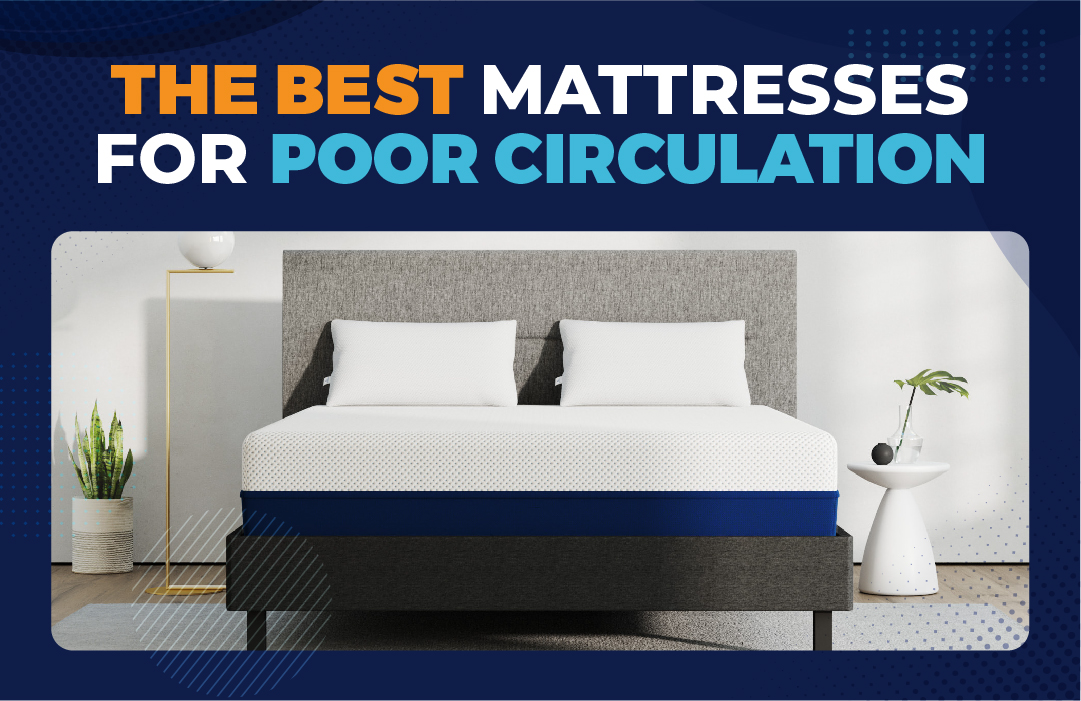



Meet The Author:
Shanir Kol
Shanir Kol, founder and CEO of SleePare, pioneered the “Try and Buy” model in eCommerce, enhancing mattress shopping by combining in-store trials with online purchases. Launching in 1999, his company focuses on customer satisfaction and eco-friendly practices, aiming to minimize mattress waste and expand sustainably.